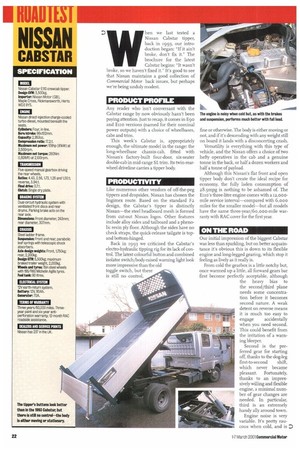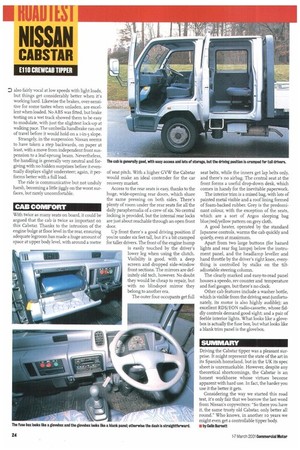vir
Page 24

Page 26

If you've noticed an error in this article please click here to report it so we can fix it.
n hen we last tested a
Nissan Cabstar tipper, back in 0993, our introduction began: "If it ain't broke, don't fix it." The brochure for the latest Cabstar begins: "It wasn't
broke, so we haven't fixed it." It's good to see that Nissan maintains a good collection of Commercial Motor back issues, but perhaps we're being unduly modest.
PRODUCT PROFILE
Any reader who isn't conversant with the Cabstar range by now obviously hasn't been paying attention. lust to recap, it comes in E90 and Eno versions (named for their nominal power outputs) with a choice of wheelbases, cabs and trim.
This week's Cabstar is, appropriately enough, the ultimate model in the range: the long-wheelbase chassis-cab, fitted with Nissan's factory-built four-door, six-seater double-cab in mid-range SL trim. Its twin-rearwheel driveline carries a tipper body.
PRODUCTIVITY
Like numerous other vendors of off-the-peg tippers and dropsides, Nissan has chosen the Ingimex route. Based on the standard F2 design, the Cabstar's tipper is distinctly Nissan—the steel headboard mesh is formed from cut-out Nissan logos. Other features include alloy sides and tailboard and a phenolic resin ply floor. Although the sides have no check straps, the quick-release tailgate is topand bottom-hinged.
Back in 1993 we criticised the Cabstar's electro-hydraulic tipping rig for its lack of control. The latest colourful button and combined isolator switch/body-raised warning light look more impressive than the old toggle switch, but there is still no control, fine or otherwise. The body is either moving or not, and if it's descending with any weight still on board it lands with a disconcerting crash.
Versatility is everything with this type of vehicle, and the Nissan offers a choice of two hefty operatives in the cab and a genuine tonne in the back, or half a dozen workers and half a tonne of payload.
Although this Nissan's flat front and open tipper body don't create the ideal recipe for economy, the fully laden consumption of 28.3mpg is nothing to be ashamed of. The Et ro's three-litre engine comes with a 12,000mile service interval—compared with 6,000 miles for the smaller model—but all models have the same three-yeart6o,000-mile warranty with RAC cover for the first year.
ON THE ROAD
Our initial impression of the biggest Cabstar was less than sparkling, but on better acquaintance it's obvious this is down to its flexible engine and long-legged gearing, which stop it feeling as lively as it really is.
From cold the gearbox is a little notc,hy but, once warmed up a little, all forward gears bar first become perfectly acceptable, although the heavy bias to the second/third plane needs some concentration before it becomes second nature. A weak detent on reverse means it is much too easy to engage accidentally when you need second. This could benefit from the irritation of a warning bleeper.
Second is the preferred gear for starting off, thanks to the dog-leg first-to-second shift, which never became pleasant. Fortunately, thanks to an impressively willing and flexible engine, a minimal number of gear changes are needed. In particular, third is an extremely handy ally around town.
Engine noise is very variable. It's pretty raucous when cold, and is also fairly vocal at low speeds with light loads, but things get considerably better when it's working hard. Likewise the brakes, over-sensitive for some tastes when unladen, are excellent when loaded. No ABS was fitted, but brake testing on a wet track showed them to be easy to modulate, with just the slightest lock-up at walking pace. The umbrella handbrake ran out of travel before it would hold on a slope.
Strangely, in the suspension Nissan seems to have taken a step backwards, on paper at least, with a move from independent front suspension to a leaf-sprung beam. Nevertheless, the handling is generally very neutral and forgiving with no hidden surprises before it eventually displays slight understeer; again, it performs better with a full load.
The ride is communicative but not unduly harsh, becoming a little jiggly on the worst surfaces, but rarely uncomfortable.
O. I •
With twice as many seats on board, it could be argued that the cab is twice as important on this Cabstar, Thanks to the intrusion of the engine bulge at floor level in the rear, ensuring adequate legroom has made a huge amount of space at upper body level, with around a metre of seat pitch. With a higher GVW the Cabstar would make an ideal contender for the car recovery market.
Access to the rear seats is easy, thanks to the huge, wide-opening rear doors, which share the same pressing on both sides. There's plenty of room under the rear seats for all the daily paraphernalia of a crew of six. No central locking is provided, but the internal rear locks are just about reachable through an open front door.
Up front there's a good driving position if you're under six feet tall, but it's a bit cramped for taller drivers. The front of the engine hump is easily touched by the driver's lower leg when using the dutch. Visibility is good, with a deep screen and dropped side-window front sections. The mirrors are definitely old tech, however. No doubt they would be cheap to repair, but with no blindspot mirror they belong to another era.
The outer four occupants get full seat belts, while the inners get lap belts only, and there's no airbag. The central seat at the front forms a useful drop-down desk, which comes in handy for the inevitable paperwork.
The interior trim is a mixed bag, with lots of painted metal visible and a roof lining formed of foam-backed rubber. Grey is the predominant colour, with the exception of the seats, which are a sort of Argos sleeping bag blue/red/yellow pattern on grey cloth.
A good heater, operated by the standard Japanese controls, warms the cab quickly and quietly, even at maximum.
Apart from two large buttons (for hazard lights and rear fog lamps) below the instrument panel, and the headlamp leveller and hand throttle by the driver's right knee, everything is controlled by stalks on the tiltadjustable steering column.
The dearly marked and easy-to-read panel houses a speedo, rev counter and temperature and fuel gauges, but there's no dock.
Other cab features indude a washer bottle, which is visible from the driving seat (unfortunately, its motor is also highly audible); an excellent RDS/ EON radio-cassette, whose fiddly controls demand good sight; and a pair of feeble interior lights. What looks like a glovebox is actually the fuse box, but what looks like a blank trim panel is the glovebox.
SUMMARY
Driving the Cabstar tipper was a pleasant surprise. It might represent the state of the art in its Spanish homeland, but in the UK its spec sheet is unremarkable. However, despite any theoretical shortcomings, the Cabstar is an honest workhorse whose virtues become apparent with hard use. In fact, the harder you use it the better it gets.
Considering the way we started this road test, it's only fair that we borrow the last word from Nissan's copywriters: "So there you have it, the same trusty old Cabstar, only better all round." Who knows, in another to years we might even get a controllable tipper body.
• by Colin Barnett
































































































